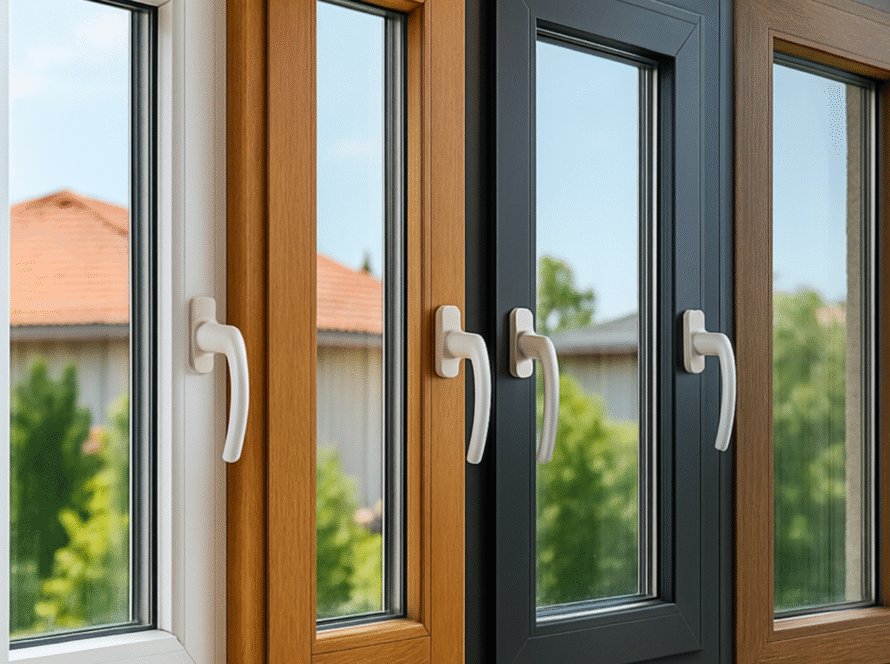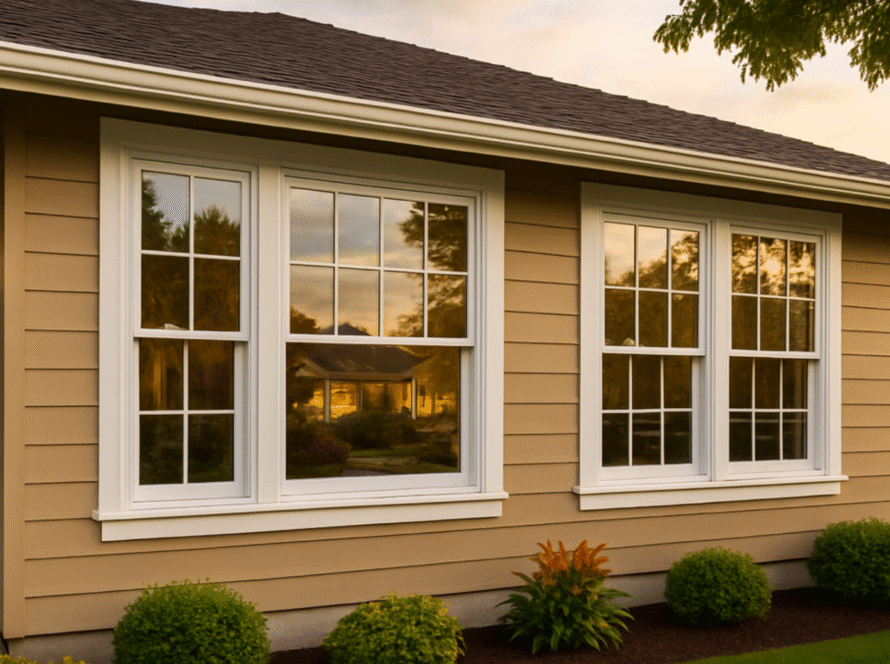
Selecting what is the best material for window frames depends on balancing durability, energy efficiency, and maintenance requirements against the Bay Area’s unique heat, fog, and coastal salt exposure.
Understanding Bay Area Climate Challenges for Window Materials
Bay Area homeowners face unique climate conditions that test the performance of window frame materials year-round. Coastal fog brings salt-laden moisture that corrodes certain materials, while inland heat and UV exposure can deteriorate frames that lack proper protection.
The question of what is the best material for window frames becomes critical when considering long-term performance in response to these environmental stresses. Different materials respond differently to temperature fluctuations, moisture exposure, and the intense California sun, which can impact window design and structural integrity over decades of service.
Professional window replacement projects succeed when material selection aligns with specific exposure conditions and performance expectations for your home’s location within the Bay Area’s diverse microclimates.
Vinyl Window Frames: The Practical Choice
Durability and Energy Efficiency Benefits
Vinyl windows dominate Bay Area installations because they resist moisture, salt air, and UV exposure without degrading. The material won’t rot, rust, or require painting, making it ideal for coastal conditions where other materials struggle with corrosion and weather damage.
Modern vinyl windows incorporate insulating chambers within their frame walls, reducing heat loss and improving thermal performance. This design helps maintain comfortable indoor temperatures while reducing energy costs, which is particularly important given the Bay Area’s utility rates and climate variations.
Maintenance Requirements and Long-Term Value
Vinyl requires minimal maintenance, with only occasional cleaning with soap and water necessary. Unlike wood, which requires regular painting or staining, or aluminum, which may show corrosion over time, vinyl maintains its appearance and performance with virtually no upkeep.
The material’s resistance to coastal conditions makes it excellent for homes near the ocean, where salt air accelerates the deterioration of less resistant materials. This durability translates to long-term value through reduced maintenance costs and extended service life.
Wood Windows: Traditional Aesthetics with Trade-offs
Natural Insulation Properties
Wood windows offer excellent thermal performance due to the material’s natural insulating properties. Wood frames help prevent heat loss more effectively than metal alternatives, contributing to energy-efficient windows that maintain comfortable indoor environments.
Quality wood species, such as pine, oak, or mahogany, can be painted or stained to complement any architectural style, making wood an attractive choice for historic homes or properties where aesthetic authenticity takes precedence over maintenance convenience.
Maintenance Challenges in Coastal Climates
Wood windows require significant maintenance in Bay Area conditions. Coastal moisture and temperature fluctuations cause wood to expand and contract, potentially affecting window operation and creating gaps that compromise energy efficiency.
Regular maintenance includes:
- Periodic painting or staining to protect against moisture
- Caulking and weatherstripping replacement as wood movement creates gaps
- Hardware adjustment to maintain smooth operation
- Inspection for rot or insect damage, especially in moisture-prone areas
Aluminum Windows: Modern Performance with Limitations
Structural Strength and Contemporary Design
Aluminum windows offer superior structural integrity for large openings and contemporary window design applications. The material’s strength allows thinner frame profiles while maintaining durability, creating cleaner sight lines that suit modern architectural styles.
Aluminum resists corrosion better than steel while providing excellent long-term stability. Quality aluminum windows incorporate thermal breaks that reduce heat transfer through the frame, improving overall energy efficiency compared to older aluminum designs.
Thermal Performance Considerations
Standard aluminum conducts heat readily, potentially creating comfort issues and increased energy costs without proper thermal separation. Modern aluminum windows address this issue through thermal breaks and insulated glazing, although they may still underperform compared to vinyl and wood in terms of pure insulation value.
The material works well in mild climates where extreme temperature differences don’t create significant comfort or efficiency challenges.
Fiberglass Windows: Premium Performance
Advanced Material Properties
Fiberglass windows represent a premium window frame material technology that combines strength, insulation, and durability. Fiberglass window frames expand and contract at rates similar to glass, reducing stress on glazing seals and maintaining energy efficiency over time.
The material resists moisture, UV exposure, and temperature extremes better than most alternatives, while providing excellent thermal performance that rivals those of wood’s insulating properties.
Investment and Value Considerations
Fiberglass windows typically cost more than vinyl or aluminum options but deliver superior performance in demanding applications. For Bay Area homes exposed to extreme coastal conditions or those prioritizing maximum energy efficiency, fiberglass offers long-term value despite its higher initial costs.
The material accepts paint and stain finishes, resembling wood, while requiring minimal maintenance, thereby combining aesthetic flexibility with practical durability.
Composite Frame Materials: Engineered Solutions
Hybrid Material Benefits
Composite frame materials combine different materials to optimize specific performance characteristics. These engineered solutions may incorporate wood fiber with vinyl or aluminum and thermal break materials, creating frames that address multiple performance requirements.
Modern composites often offer better thermal performance than pure aluminum while providing greater durability than solid wood, positioning them between traditional materials in terms of both cost and performance.
Application-Specific Advantages
Composite materials work particularly well for specialized applications like:
- New construction windows installation where performance specifications are critical
- Fire rated windows installation requiring specific fire resistance properties
- Soundproof windows installation where frame rigidity affects acoustic performance
Matching Materials to Specific Applications
Coastal Exposure Considerations
Homes within five miles of the Bay or ocean face accelerated corrosion from salt air. Vinyl and fiberglass perform best in these conditions, while wood requires extensive protection and aluminum needs quality coatings to prevent pitting and discoloration.
Consider material selection based on:
- Direct salt air exposure levels
- Prevailing wind patterns that carry moisture
- Maintenance accessibility for ongoing care
- Budget for initial investment and long-term upkeep
Energy Efficiency Priorities
For maximum energy-efficient window performance, prioritize materials with:
- Low thermal conductivity to reduce heat transfer
- Minimal expansion and contraction that maintains seal integrity
- Compatibility with high-performance glazing systems
- Frame designs that accommodate insulation and weatherstripping
Architectural Integration
Window type and architectural style influence material selection:
- Historic homes often require wood for authenticity
- Contemporary designs benefit from aluminum or composite materials
- Traditional styles work well with vinyl that mimics wood profiles
- Custom applications may require specialized composite solutions
Making Your Material Decision
Evaluating Total Performance
The best window frame material balances multiple factors:
- Initial cost and installation requirements
- Expected maintenance over the window’s lifespan
- Energy efficiency contribution to comfort and utility costs
- Durability against local environmental conditions
- Aesthetic integration with your home’s design
Professional Assessment Benefits
Experienced contractors understand how different materials perform in specific Bay Area microclimates. Their guidance helps ensure material selection delivers optimal performance for your home’s unique conditions and requirements.
Consider consulting professionals who can evaluate:
- Your home’s specific exposure conditions
- Integration requirements with existing systems
- Local building code requirements and restrictions
- Long-term cost implications of different material choices
Optimizing Frame Material Selection
Ultimately, the best material for window frames depends on balancing performance, maintenance, and cost considerations against your specific needs and conditions. The Bay Area’s diverse climate requires materials that can handle both coastal moisture and inland heat, while providing energy efficiency and durability.
Vinyl offers the best overall value for most applications, combining low maintenance with good performance and reasonable costs. Wood offers superior aesthetics and insulation, but it requires ongoing maintenance. Aluminum suits modern designs with proper thermal breaks, while fiberglass provides premium performance at a higher cost.
Focus on materials that match your long-term plans, maintenance preferences, and performance priorities. Quality installation matters just as much as material selection, so work with experienced professionals who understand the Unique conditions of the Bay Area.
Contact a Bay Area window expert today to explore frame material options that deliver optimal performance for your specific location and requirements.
Since 1987, Insight Glass has provided top-quality windows & patio doors in the Bay Area.
Call 707-746-6571 for Expert Installation!
CONTACT US TO GET A FREE ESTIMATE!


